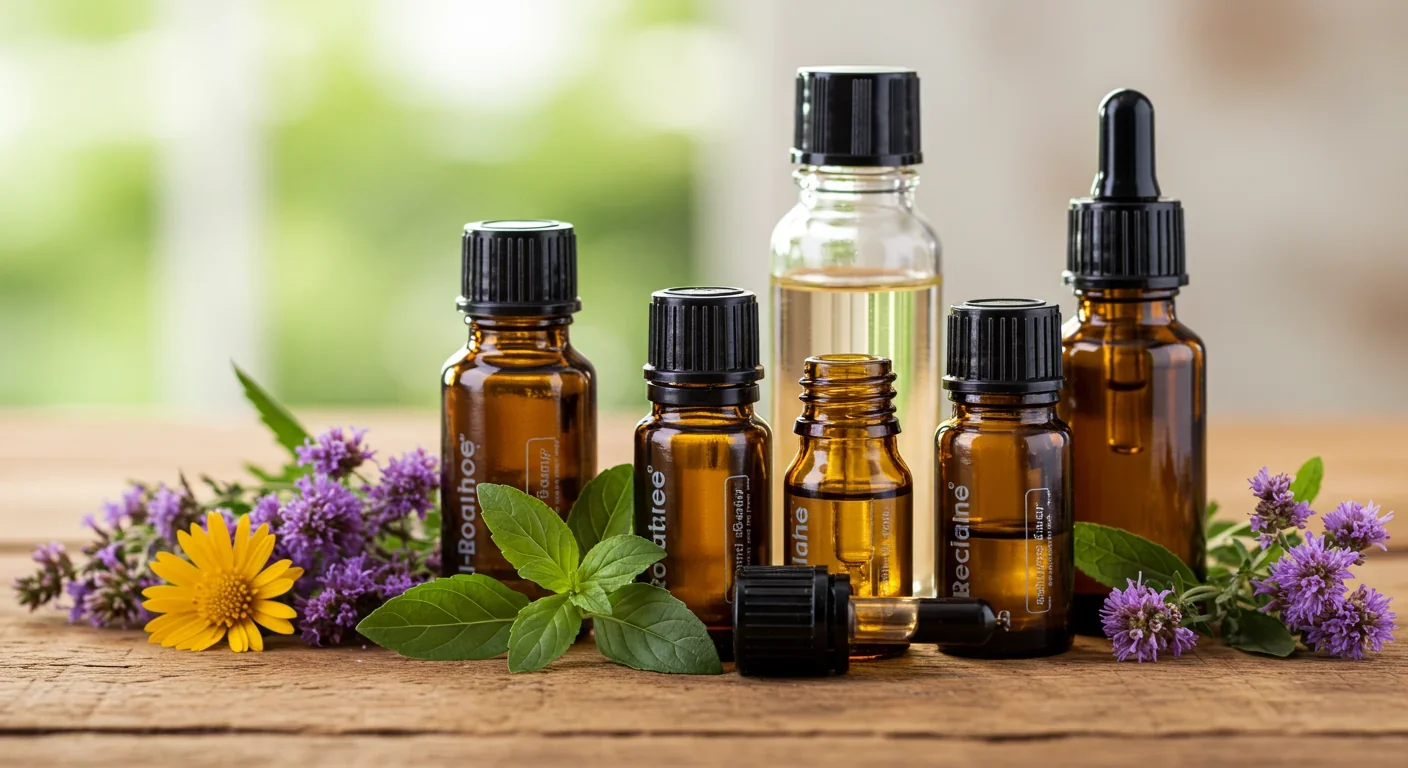Why Your Brain Is Hardwired to Lose Money

TL;DR: Smell has a unique neural shortcut to your brain's emotional and memory centers, bypassing the thalamus to connect directly to the amygdala and hippocampus. This explains why certain scents can trigger vivid, emotionally intense memories from decades ago—especially from childhood when your olfactory system was already fully developed.

Walk past a bakery, and suddenly you're five years old again, watching your grandmother knead dough. Catch a hint of sunscreen, and you're transported to that beach vacation from two decades ago. These aren't just random flashbacks—they're windows into one of the most fascinating partnerships in your brain, where smell and memory work together in ways that scientists are only now beginning to understand.
While you can forget faces and forget names, your nose apparently never forgets. That's because smell takes a neurological shortcut that other senses can't match, racing straight to the parts of your brain that handle emotions and memories. It's a direct line to your past, and it's powerful enough to unlock experiences you didn't even know you still remembered.
Here's what makes smell different: it's the only sense with VIP access to your brain's emotional core. When you see, hear, or touch something, those signals take a detour through the thalamus—think of it as the brain's central processing hub. But smell? It goes straight to the source.
"The olfactory system has the only direct superhighway access to the memory centers and the emotional center of the brain," explains Michael Leon, Professor Emeritus of Neurobiology and Behavior at the University of California, Irvine. This direct route connects the olfactory bulb—your brain's smell processing center—straight to the amygdala and hippocampus, the regions that handle emotional memories and long-term storage.
Unlike every other sense, smell bypasses the brain's central relay station and connects directly to your memory and emotion centers—explaining why a single scent can hit you like an emotional freight train.
This anatomical quirk means odors can trigger memories faster and with more emotional punch than anything you see or hear. The olfactory nerve is the shortest cranial nerve and follows the most direct route to the brain, allowing smell signals to reach your limbic system—the emotional brain—in milliseconds, without any intermediary checkpoints.

French novelist Marcel Proust described this phenomenon over a century ago, when the taste and smell of a madeleine cake dipped in tea triggered a flood of childhood memories so vivid they filled thousands of pages. Scientists now call it the "Proust effect," and while Proust was writing fiction, neuroscience has proven he was onto something real.
Research shows that odor-triggered memories are rated as more emotional than memories evoked by visual or verbal cues. In a 2006 study by psychologist Maria Larsson at Stockholm University, 93 people aged 65-80 were presented with smells, pictures, and words. The results were striking: odor cues pulled up memories from the first decade of life, while pictures and words mostly triggered recollections from early adulthood. More importantly, the smell-triggered memories came with stronger emotional responses.
Think about what that means. Your brain is holding onto scent memories from when you were five, six, seven years old—ages when your visual and verbal memory systems were still developing. Those early smell experiences are locked in deep, tagged with emotions that haven't faded over the decades.
There's a reason so many powerful scent memories come from childhood. Your sense of smell develops extraordinarily early—even before you're born. By mid-pregnancy, fetuses can already detect the foods their mothers eat, and these early exposures can shape lifelong preferences and memories.
This early development gives smell a massive head start over your other senses. While you were still learning to talk and make sense of what you saw, your olfactory system was already operating at full capacity, encoding the world around you in scent. The result? A library of smell memories that stretches back further than almost anything else you can recall.
Jonas Olofsson, a cognitive psychologist whose research has explored olfactory memory timelines, found that "olfactory memories do not come from the same time period as other memories." While most people's strongest visual or verbal memories cluster around their late teens and twenties—what researchers call the "reminiscence bump"—the olfactory bump appears much earlier, between ages six and ten.
"The smell of lily of the valley, for example, can remind us of the bouquet of flowers we picked that special last summer before starting school."
— Jonas Olofsson, cognitive psychologist
These aren't just interesting quirks. They're clues to how your brain prioritizes what matters. Early childhood is when you're learning what's safe, what's dangerous, what's home, what's foreign. Smell helped your ancestors survive by quickly identifying food, predators, and kin. That evolutionary pressure wired smell deeply into the systems that keep you alive—and those connections remain just as powerful today.

So what happens in your brain when a familiar scent triggers a memory? The process is remarkably fast and involves multiple brain regions working in concert.
When odor molecules hit the receptors in your nose, they activate about ten million olfactory receptor neurons that send signals to the olfactory bulb. From there, the information travels along direct pathways to the amygdala—which assigns emotional significance—and the hippocampus—which handles memory encoding and retrieval.
This direct connection means emotional tagging happens almost instantaneously. A 2011 study from MIT's Picower Institute of Learning and Memory revealed another layer: seemingly irrelevant details can get permanently linked to memories if they're experienced within about 90 minutes of each other. That explains why the scent of fresh-cut grass might trigger memories not just of summer, but of the specific shirt you were wearing, the exact temperature of that afternoon, the sound of cicadas.
"Our finding explains, at least partially, why seemingly irrelevant information like the color of the shirt of an important person is remembered as vividly as more significant information," noted Susumu Tonegawa, one of the study's authors.
Understanding the smell-memory connection isn't just intellectually interesting—it has real therapeutic potential. Researchers are exploring how odor cues might help people with depression, PTSD, Alzheimer's, and other conditions that affect memory and emotional regulation.
A 2024 study published in JAMA Network Open found that odor cues led to more detailed memories than word cues in adults with major depressive disorder. Kymberly Young, the study's lead researcher and an Associate Professor of Psychiatry at the University of Pittsburgh, suggests this could open new avenues for therapy: using carefully selected scents to help patients access and process difficult memories in a more detailed, emotionally rich way.
Smell training—exposing yourself to diverse scents regularly—can actually strengthen memory pathways and may slow cognitive decline, according to recent neuroscience research.
For patients with Alzheimer's and dementia, introducing familiar scents has shown promise in stimulating memories and improving emotional responses. When other memory systems are failing, the ancient olfactory pathways often remain at least partially intact, providing a lifeline to identity and personal history.

There's even evidence that actively training your sense of smell can boost cognitive function in healthy people. A 2023 study published in Frontiers in Neuroscience had participants use scented diffusers for two hours each night over six months. The results? Significant improvement in memory performance and measurable changes in the uncinate fasciculus, a critical white matter pathway connecting the olfactory system to memory regions.
Not all scents are created equal when it comes to triggering memories. Personal and cultural experiences shape which smells become meaningful memory anchors. As Venkatesh Murthy points out, while a few odors like rotting food have nearly universal negative associations, most pleasant or meaningful scents are highly individual.
The smell of pipe tobacco might unlock warm memories for someone whose beloved grandfather smoked a pipe, while triggering nothing for someone without that association. Pumpkin spice evokes fall nostalgia for Americans who grew up with Thanksgiving traditions, but means little to people from cultures without those rituals.
Timing matters too. Smells encountered during emotionally significant moments—first love, traumatic events, major life transitions—get encoded with extra strength. Your brain essentially turns up the volume on memory formation during emotional events, and because smell has that direct line to the amygdala, scent memories formed during these moments can be incredibly persistent.
Why did evolution wire smell so directly into our emotional and memory systems? Survival. For our ancestors, the ability to quickly recognize and remember odors could mean the difference between eating safe food and poisoning yourself, between avoiding predators and becoming prey.
Smell develops early because infants need it. Before you could see clearly or understand language, you could smell your mother and distinguish her from strangers. You could smell milk. You could smell danger. These weren't luxuries—they were essential survival tools that needed to come online fast.
The emotional intensity of smell memories also makes evolutionary sense. If a particular scent was associated with getting sick, you needed to remember that powerfully enough to avoid it in the future. If a smell signaled safety, comfort, or nourishment, remembering it could guide you toward resources and away from threats.

Even though modern humans don't face the same survival pressures, we're still running on the same neural hardware. That ancient wiring explains why the scent of smoke can trigger instant alarm, why the smell of certain foods can provoke nausea if you once got food poisoning, why your grandmother's perfume can make you feel safe decades after you last saw her.
Not everyone experiences olfactory memory with the same intensity. Some people report vivid, emotionally overwhelming smell-triggered memories, while others notice the phenomenon less. What accounts for these differences?
Genetics play a role. Humans have about 400 different types of olfactory receptors, but which ones you have—and how well they function—varies from person to person. Some people are "supersmellers" with heightened olfactory sensitivity, while others have diminished smell perception. These differences can affect both how well you detect odors and how strongly they're encoded into memory.
Age matters too. Olfactory function typically peaks in early adulthood and gradually declines with age, though the rate of decline varies widely. Interestingly, while your ability to detect faint odors may weaken as you age, those deeply encoded childhood smell memories often remain accessible. That's why a 70-year-old might struggle to smell subtle spices in food but still be transported back to childhood by the scent of a specific flower.
"The sense of smell's capacity to trigger people's childhood memories seems to be universal, even though the specific smells and memories vary from person to person."
— Venkatesh Murthy, neuroscientist at Harvard University
Attention and awareness also shape olfactory memory. People who actively pay attention to smells—perfumers, chefs, wine tasters—often report richer smell memories than those who largely ignore odor information. This suggests that like other cognitive abilities, olfactory memory can be strengthened with practice and conscious attention.
Understanding how smell and memory work together opens up practical applications beyond clinical settings. Students have used "scent pairing" to boost test performance: study with a particular scent like lavender essential oil, then smell the same scent before the exam to help retrieve information.
The technique works because you're essentially giving your brain an additional retrieval cue. Your hippocampus doesn't just store what you learned—it also stores the context, including the smells present during encoding. Recreating that olfactory context during retrieval can make the information more accessible.
Some people use signature scents intentionally to create positive associations. Wearing a specific perfume during a happy period of your life can turn that scent into a bottled memory, ready to evoke those feelings whenever you want. Conversely, avoiding scents associated with negative experiences can help you move past them.
Despite decades of research, scientists still have big questions about olfactory memory. While the anatomical pathways are well-mapped, the mechanistic details—exactly how a specific odor maps onto a particular autobiographical memory—remain partly mysterious.
"Scientists are in the same boat as lay people now," Murthy admits. "We think that smell is special is very plausible, but what's the evidence?"
Part of the challenge is methodological. Unlike experiments with mice, where researchers can directly measure neural activity and control variables precisely, human memory studies rely on self-reporting. People can describe their memories, but scientists can't directly observe the subjective experience of remembering. This makes it difficult to establish definitive causal links between specific neural patterns and the rich, complex experience of a smell-triggered memory.
Animal models help map the basic circuitry, but they can't capture the full richness of human autobiographical memory. Mice can be trained to associate scents with rewards or punishments, demonstrating that odor-emotion connections exist, but they can't tell us about the narrative quality of human memory—the way a smell doesn't just trigger an emotion but can unfold an entire scene, complete with visual details, sounds, and a sense of being transported back in time.
As neuroscience tools improve, researchers are getting better at bridging this gap. Advanced brain imaging techniques can now track activity across multiple brain regions simultaneously, revealing how smell, emotion, and memory systems interact in real time. Machine learning algorithms are helping decode patterns in brain activity, potentially moving us closer to understanding the neural signatures of specific memories.
There's also growing interest in using olfactory training as a preventive tool for cognitive decline. If regularly engaging your sense of smell can strengthen memory pathways and slow age-related decline, we might see smell training becoming part of standard recommendations for healthy aging, alongside physical exercise and mental stimulation.
The clinical applications continue to expand as well. Researchers are exploring whether olfactory cues could help people with PTSD process traumatic memories more safely, whether scent-based therapies could support addiction recovery by helping people access pre-addiction memories of their identity, and whether smell training could aid rehabilitation after brain injuries.
What makes the Proust effect so compelling isn't just the neuroscience—it's the experience. There's something almost magical about how a scent can collapse time, making the past feel present in a way that photos and stories can't quite match. A photo shows you what something looked like; a story tells you what happened. But a smell makes you feel like you're there again.
Maybe that's because smell is so tied to the limbic system, the ancient, emotional brain that existed long before we developed language or complex visual processing. When you smell something from your past, you're not just remembering—you're feeling the original emotion, accessing a layer of experience that words and images can't fully capture.
Scientists will continue mapping the circuits, identifying the molecules, quantifying the effects. But they're studying something that touches the core of what makes us human: our ability to carry our past with us, to be moved by something as simple as a whiff of perfume or the smell of rain on pavement.
The next time a scent stops you in your tracks and pulls you backward through time, you'll know why. It's not magic, though it might feel like it. It's your olfactory bulb talking directly to your amygdala and hippocampus, following pathways laid down when you were young, activating memories encoded with emotional intensity that other senses can't match.
And in that moment, neuroscience and lived experience converge: a single breath containing an entire world that you thought you'd forgotten, proving that your brain never really lets go—it just waits for the right scent to bring it all back.

MOND proposes gravity changes at low accelerations, explaining galaxy rotation without dark matter. While it predicts thousands of galaxies correctly, it struggles with clusters and cosmology, keeping the dark matter debate alive.

Ultrafine pollution particles smaller than 100 nanometers can bypass the blood-brain barrier through the olfactory nerve and bloodstream, depositing in brain tissue where they trigger neuroinflammation linked to dementia and neurological disorders, yet remain completely unregulated by current air quality standards.

CAES stores excess renewable energy by compressing air in underground caverns, then releases it through turbines during peak demand. New advanced adiabatic systems achieve 70%+ efficiency, making this decades-old technology suddenly competitive for long-duration grid storage.

Our brains are hardwired to see patterns in randomness, causing the gambler's fallacy—the mistaken belief that past random events influence future probabilities. This cognitive bias costs people millions in casinos, investments, and daily decisions.

Forests operate as synchronized living systems with molecular clocks that coordinate metabolism from individual cells to entire ecosystems, creating rhythmic patterns that affect global carbon cycles and climate feedback loops.

Generation Z is the first cohort to come of age amid a polycrisis - interconnected global failures spanning climate, economy, democracy, and health. This cascading reality is fundamentally reshaping how young people think, plan their lives, and organize for change.

Zero-trust security eliminates implicit network trust by requiring continuous verification of every access request. Organizations are rapidly adopting this architecture to address cloud computing, remote work, and sophisticated threats that rendered perimeter defenses obsolete.